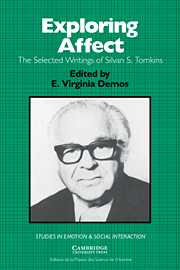Book contents
- Frontmatter
- Contents
- Foreword
- Editor's preface
- List of contributors
- Chronology
- Introduction
- Part I Affect theory
- Introduction
- Selections by Silvan S. Tomkins
- Part II Affect and ideology
- Introduction
- Selections by Silvan S. Tomkins
- Part III The face of affect
- Introduction
- Silvan Tomkins and facial expression
- Selections by Silvan S. Tomkins
- Part IV Script theory: The differential magnification of affect
- Introduction
- Selections by Silvan S. Tomkins
- Part V Human being theory: A foundation for the study of personality
- Introduction
- Selections by Silvan S. Tomkins
- A complete annotated bibliography of Silvan S. Tomkins's writings
- References
- Author index
- Subject index
- Titles in the series
Silvan Tomkins and facial expression
Published online by Cambridge University Press: 10 November 2010
- Frontmatter
- Contents
- Foreword
- Editor's preface
- List of contributors
- Chronology
- Introduction
- Part I Affect theory
- Introduction
- Selections by Silvan S. Tomkins
- Part II Affect and ideology
- Introduction
- Selections by Silvan S. Tomkins
- Part III The face of affect
- Introduction
- Silvan Tomkins and facial expression
- Selections by Silvan S. Tomkins
- Part IV Script theory: The differential magnification of affect
- Introduction
- Selections by Silvan S. Tomkins
- Part V Human being theory: A foundation for the study of personality
- Introduction
- Selections by Silvan S. Tomkins
- A complete annotated bibliography of Silvan S. Tomkins's writings
- References
- Author index
- Subject index
- Titles in the series
Summary
Silvan Tomkins deserves much of the credit for the renewed interest in facial expression which has developed in the last two decades. His affect theory (see Part I) emphasized the importance of the face, providing a new conceptual framework for considering expression and emotion. It was a framework which emphasized the role of biology and which conceived of emotion in terms of eight discrete, quite different affects, rather than two or three affective dimensions. At the time Silvan first wrote about the face, the only other psychologist publishing on expression was Harold Schlosberg (1941, 1952, 1954), but his approach to expression – trying to account for judgments in terms of a few underlying dimensions – did not awaken the interest of many others. Unlike Schlosberg, (who told me he never looked at the faces he showed to judges), Tomkins was fascinated by faces themselves. He was an extraordinarily keen interpreter of expression.
The first article in this section, his publication in 1964 with McCarter, had little direct impact on the field of psychology, then or now, but it had an enormous impact on me. It is amazingly rich in theoretical ideas. And it is the first empirical study I had encountered which showed that observers could reach very high levels of agreement in judging which of eight emotions was shown in an expression. The secret of Tomkins's success was his keen eye.
Information
- Type
- Chapter
- Information
- Exploring AffectThe Selected Writings of Silvan S Tomkins, pp. 209 - 214Publisher: Cambridge University PressPrint publication year: 1995
Accessibility standard: Unknown
Why this information is here
This section outlines the accessibility features of this content - including support for screen readers, full keyboard navigation and high-contrast display options. This may not be relevant for you.Accessibility Information
- 5
- Cited by
